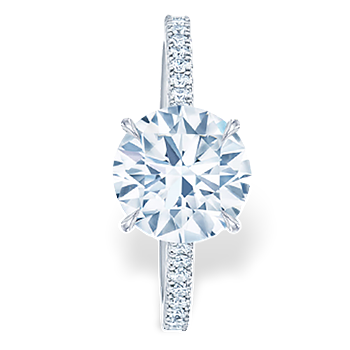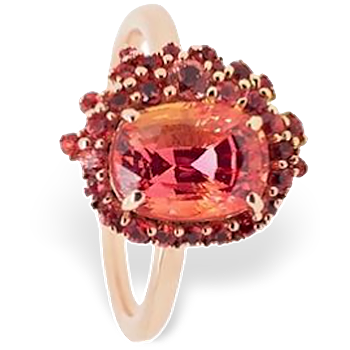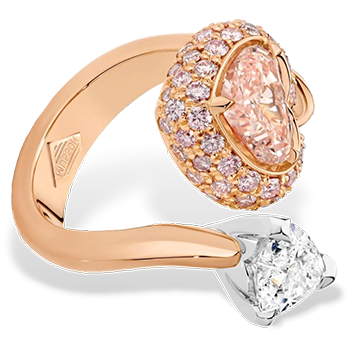For many successful jewellers the engagement and wedding category continues to be the pillar.
An engagement ring is often the most expensive piece of jewellery a woman will wear.
For men it’s an expenditure that not only requires advanced planning and painstaking preparation – especially for those customers who, outside of a gift for a girlfriend or relative, have spent very little time, if any, inside a jewellery store.
Local and international media frequently report that young people are increasingly delaying marriage in favour of travel and career advancement – possibly sour news for many jewellers.
According to Australian Bureau of Statistics (ABS) data, 2014 was the peak year for Australian marriages -123,243 to be precise.
The COVID pandemic and the subsequent restrictions on public gathering struck a major blow to the jewellery trade in more than one way. The first, of course, was the immediate minimisation of foot traffic and the loss of direct access to customers.
The second, less obvious, pain point was delayed weddings during lockdowns. While it’s true that many couples ‘pushed on’ during the pandemic and pursued alternative means of marriage, others were greatly burdened by the overwhelming uncertainty of the societal climate.
Numbers game
In 2020, 78,989 Australians were married and in 2021 there was an increase of 10,175 marriages to 89,164.
Beyond the impact of the pandemic these numbers remain incongruous with Australia’s rise in population.
As of late December 2022, there were approximately 26.22 million people living in Australia.
In 2000 Australia’s population sat at 18.99 million and had increased 10 years later to 22.15 million.
The population has grown by a third within 23 years and yet the number of marriages has remained otherwise stable - with 103,130 couples wed in 2001 for reference.
In a report titled ‘Fewer Putting A Ring On It’ the ABS offers further context.
“The crude marriage rate [the number of marriages registered in a year per 1,000 Australian residents] fluctuated across the first half of the twentieth century. The all-time high was in 1942. Following an increase in the 1960s, the rate began to fall steadily from 1970 until 2000. It then stabilised for a decade before falling again,” the report reads.
“The fall in the marriage rate over the past half-century has been influenced by a range of demographic and social changes, including extended time in pursuing education beyond year 12 with increasing demands for a skilled workforce; increased labour force participation of women, especially mothers; the availability of the pill, which enabled a disconnection between marriage and childbearing; the rise in cohabitation, and a change in attitudes towards marriage.”
University of Melbourne sociologist Professor Belinda Hewitt tells the Sydney Morning Herald that for the youngest generations the concept of marriage no longer offers the allure it once did.
“There’s almost no legal reason to get married anymore,” she explains.
“Laws around property distribution and custodial arrangements with children are essentially the same for cohabiters. Marriage is no longer an economic necessity, and is free from religious and patriarchal pressure.”
Similar issues have been reported overseas. In the UK, Betts Group head of operations Julie Rogers says that economic pressures have also been unkind to the bridal industry.
“Rapid inflation and the cost-of-living crisis are likely to cause a reduction in the number of marriages as we see a slowdown in luxury expenditure,” she explains to Professional Jeweller.
“With an increasing focus on sustainability, many brides may look to wear family heirlooms or have them reworked, generating a different set of opportunities for jewellers.”
|
 |  |  |
Matthew Ely | Kwiat | Pink Kimberley |
 |  |  |
Mark McAskill | Brilliant Earth | Vrai |
 |  |  |
Solid Gold | Sapphire Dreams | Kwiat |
|
Good news
Fortunately for Australia’s jewellers there are many positive findings to overshadow this curious societal stalling.
Spearheaded by Ashley Portas, Brisbane’s Diamondport Jewellers published the findings of a voluntary online 2022 survey in September assessing the engagement ring market.
Among the more interesting observations was that the average amount spent on an engagement ring was approximately $5,297 – a notable increase from an average sale price of $2,579 recorded by a similar study 10 years earlier.
“First up, we should start with the question of budget. Most people had a budget in mind when they set out to buy an engagement ring. Of the people who had a budget at the outset, 77 per cent stuck to it when buying the engagement ring,” the report explains.
A total of 4 per cent of respondents spent more than $20,000 on their engagement ring and 1.5 per cent spent more than $25,000.
Fascinating study
Each year Easy Weddings, an event planning service, conducts a study known as the Australian Wedding Industry Report (AWIR), compiling data from an extensive survey of thousands of recently engaged and married couples across Australia.
The 2023 edition of the AWIR contains insight from more than 3,500 couples and 600 wedding businesses.
According to the report the average expected wedding budget was $27,550 while the actual average cost was $34,715 – breaking the budget by more than 25 per cent.
“Spending took a dip during the peak pandemic when many Australian couples opted for micro-weddings and scaled back guest numbers. By 2021, spending quickly surpassed 2019 costs in all states except Tasmania. A year on, the average cost of weddings has eclipsed pre-pandemic spending nationally,” the report reads.
“Likewise, the average cost of an engagement ring has increased on post-pandemic prices — by 11.8 per cent in fact. Couples are now spending an average of $6,000 on an engagement ring, up from $5,367 in 2019.”
With many analysts seeing dark clouds on the economic horizon the AWIR advises suppliers in the wedding trade to prepare for customers with tighter purse strings.
“We expect to see a rise in budget-conscious couples, so wedding suppliers should be upfront about pricing from the outset,” the report advises.
“To get realistic about how to price your services as a wedding supplier, we’d encourage you to take a look at the state-by-state average wedding budget and dive into your specific category so you can get to the most competitive pricing or the pricing that works best for you and your business.”
What’s trending?
Modern brides are said to be more creative than ever before due to the popularity of blending traditional styles with a modern touch.
This is more good news for jewellers as the variety is expanded for what it is possible to offer – whether it be a ring that emanates timeless and classic appeal or a piece that commands attention due to its unique nature.
Whether a customer is looking for a ring that showcases their personality or something that will stand the test of time – jewellers are able to offer both.
Naturally, opinions of designers, retailers, suppliers and industry analysts on what will capture the hearts and minds of brides and brides-to-be alike in 2023 differ right across the industry.
Based in Mermaid Beach in Queensland, Catherine Pevy-Trewartha is the owner of My Jewellery Shop. She says that one of the most interesting trends she’s observed is not which products customers are preferring, but the method by which they make their selection in the first place.
“We have seen more couples coming in to design or choose engagement rings together,” she tells Jeweller.
“We find that they prefer to have an appointment where they can be involved in the design process and have a more personal experience. Many of them are wanting to support a local family-owned business rather than a shopping centre jeweller.”
Daniel Christopher, owner of Daniel Christopher Jewellery in London, says that spending on engagement rings rose by more than 50 per cent in 2022 on a year-on-year comparison and has observed similar patterns in consumer behaviour.
“When couples are shopping together, the man is more likely to push the boat out to ensure their partner receives their dream ring,” he tells Professional Jeweller.
“Men on their own will tend to be far more cautious in the design that they select, and opt for a safe, classic solitaire ring, whereas couples buying together are led by the recipient and tend to be far more adventurous.”
Pevy-Trewartha also says she’s witnessed a rise in interest in a category thought to be otherwise dated.
“We have noticed a strong move back to yellow gold in all jewellery including engagement and wedding rings. Women are aspiring to have a larger statement solitaire diamond engagement ring and we have also seen a transition from a top halo surrounding the main stone to a hidden halo to complement the solitaire diamond,” she reports.
“Women are now choosing to have two wedding rings rather than waiting and hoping for their eternity ring. Men are tending to be open to spending a little more on their wedding rings with 18-carat yellow gold seeing a resurgence and newer metals such as tantalum rather than titanium a great option as it can be sized, and platinum for its strength and affordability.”
|
 |  |  |
Carla Maxine | Calleija | Leibish |
 |  |  |
Scott West | Ellendale Diamonds | Gubelin |
|
Personalisation
Kyha Scott, designer and owner of Kyha Studios, says that following a two-year wedding hiatus during the pandemic couples are increasingly seeking personalisation.
“Post-pandemic brides are increasingly seeing their wedding as an expression of self and that often means multiple wedding looks to capture the many facets of their personal style,” she tells Vogue.
“It’s the introduction of crystal and mixed crystal and pearl pieces that will really start to take off in 2023. Whether it’s just a scattering on a veil, or a cluster of pearl detailing is a modern classic and is another timeless look that’s on our radar for 2023.”
Megan Greaney of Michael Hill International agreed with Scott on the prioritisation of personalisation in contemporary weddings.
“For one of their most significant pieces of jewellery, modern brides are increasingly seeking out ways to make their engagement ring feel unique and individual. While this sometimes takes a clear form, such as an unusual design or an alternative gemstone, it’s a more subtle form of personalisation that’s currently trending,” she explains.
“Modern creative halos make use of mixed diamond cuts and unusual placements to create intricate or bold shapes; often altering the shape of the centre stone rather than simply amplifying its size.”
Multi-stones
Sarah Munro, co-founder of Australian fine jewellery business Sarah & Sebastian, says that when it comes to wedding and engagement trends jewellers can expect to see the trends of 2022 continuing strong.
“Diamond wedding bands that feature fancy cut diamonds, like pears or ovals, are the most requested,” Munro tells Vogue. “We see this continuing into 2023.”
“Multi-diamond rings, with stones in various shapes, will continue to be popular into next year. We’ve seen an uptick of rings where stones are purposefully off-tilt or shifted to an unexpected angle. Our clients like to express their endearment in their own way, so the break from the traditional feels special and meaningful. I think altering the orientation and combination of gemstones is a mainstay.”
Lab-created diamonds
Lab-created diamonds have been a hot topic in the jewellery industry for more than a decade and the debate doesn’t appear to be ending any time soon.
Kaylene Fitzpatrick, owner of Kadia Jewellery in Toronto, NSW, says that like many she was once unsure of the potential for success.
“I was one of those who was sitting on the fence with lab-created diamonds, being stubborn and true to natural diamonds,” she tells Jeweller.
“But customers have changed my mind with a growing demand for custom-made lab-created diamond engagement rings. They want big but with a budget.”
Allison English, owner of Byrnes Jewellers in Mudgee, NSW, reported a similar experience and says it’s a trend that’s particularly strong with younger consumers.
“Lab-created diamonds are a big thing at the moment, particularly with the younger generation,” she says.
“The youngest consumers in my experience are hoping to get more show for their ‘dough’.”
Pevy Trewartha was an early adopter of the lab-created diamond variety and says that early initiative has proven rewarding.
“As one of the first stores to embrace lab-created diamonds back in 2016, we have continued to increase our lab-created diamond business with consumers seeking us out and specifically asking for lab-created diamonds when designing engagement and wedding rings,” she says.
“Our average size of lab-created diamond engagement rings now exceeds the traditional 1-carat size with 1.5-3-carats now very normal. Fancy shape lab-created diamonds have also been very popular with oval-shaped engagement rings surpassing round brilliant cuts, with pear shape and radiant cuts following closely behind. Marquise-shaped diamonds are also seeing a comeback.”
|
 |  |  |
Eva Fehren | Soklich & Co. | Musson |
 |  |  |
Artemer | Murazzo | Stuller |
|
An alternative?
What better way to pursue individuality than by exploring an alternative to diamonds?
Gwen Farrell, writer for Evie, says that the options are almost endless. “The most popular gemstones currently dominating the alternative engagement ring business - and for good reason - are morganite and moissanite. These stones are durable, cost-effective, and most importantly, sparkly and stunning. Morganite has a unique pink-to-blush tint and is in the same gemstone family as stones like aquamarine and emerald,” she explains.
“Other less-common gemstones include alexandrite, which has a [Mohs] rating of 8.5 and changes colour from green to purple to red, depending on the lighting. You might also see stones like agate, rose quartz, tourmaline, chrysoprase, and tanzanite becoming more popular.”
Munro says that engagement pieces featuring emeralds are increasingly popular.
“We are receiving more requests for emeralds as a centre-stone option for engagement rings. I personally consider emeralds to be one of the most beautiful gemstones— their green hues are unparalleled, ” she says.
Director of Adelaide’s Utopian Creations, Ben Manning, believes that brides that seek a ring that doesn’t feature diamonds have opened the door for some of Australia’s most unique and beautiful gemstones to shine.
“Coloured gemstone jewellery continues to be our focus, predominantly Australian sapphire engagement rings. We’ve seen a slow and steady rise in people searching for Australian sapphires over the past 10 years with a more pronounced rise over the past five years,” he tells Jeweller.
“The rise of Australian sapphires as engagement ring stones has surprised us and I’m sure the rest of the industry, both in Australia and overseas.”
Til death do us part
Despite the unusual quirks of Australia’s demographics and evolving attitudes towards marriage and long-term commitment, the wedding and engagement jewellery category remains healthy, albeit looking rather different to what it did 10, 20 or 50 years ago.
Australian couples pursuing marriage are demanding personalisation, customisation and greater variety like never before.
Fortunately for the jewellery industry, these demands have introduced an increasing array of potential offerings, handing businesses the chance to stand out from the crowd by mastering a variety of niches – be they it classic and timeless designs or creative and unique bespoke pieces.
READ EMAG